After a fifth-place finish last season and prevailing in the playoffs, propelling them into the UEFA Europa Conference League playoff round, manager Ron Jans left FC Twente, requiring a manager heading into the summer.
Luckily, Twente did not have to try and find a replacement for too long.
They brought in 51-year-old Dutchman Joseph Oosting at the beginning of July, with ample time to prepare for the campaign.
Oosting was brought in from fellow Eredivisie side RKC Waalwijk. The Dutchman had guided them to respective 10th and ninth-placed finishes in the previous two Eredivisie seasons.
His start at Twente has been perfect, at least domestically, with the Dutch side winning all four of their opening Eredivisie matches.
Though they crashed out of the UEFA Europa Conference League playoffs with a heavy defeat over two legs to Turkish side Fenerbahçe, the side is starting to gel with the tactics Oosting is beginning to implement and the new signings that came in during the summer transfer window.
This tactical analysis and scout report will
examine the 51-year-old Dutch manager’s tactics more in-depth and analyse Twente’s excellent start to the Dutch league season. Without the added schedule of European football, Twentemay be able to go one step further this season under Oosting and get into the top three.
Joseph Oosting’s Style Of Play
A few tactical trends have started to appear when considering Twente in possession of the ball four games into this new Eredivisie season.
Whether it is full-backs inverting with the wide midfielders moving into wider positions or the quick passing sequences and verticality in their game, Joseph Oosting has his Twente side playing clinical attacking football at this early point in the season.
Regarding progressing the ball into the attacking third, Oosting’s side have heavily relied on through passes, with Twente’s 65 in four games this season the highest total in the Eredivisie.
Twente also have the highest through pass accuracy in the league this term (41.5%).
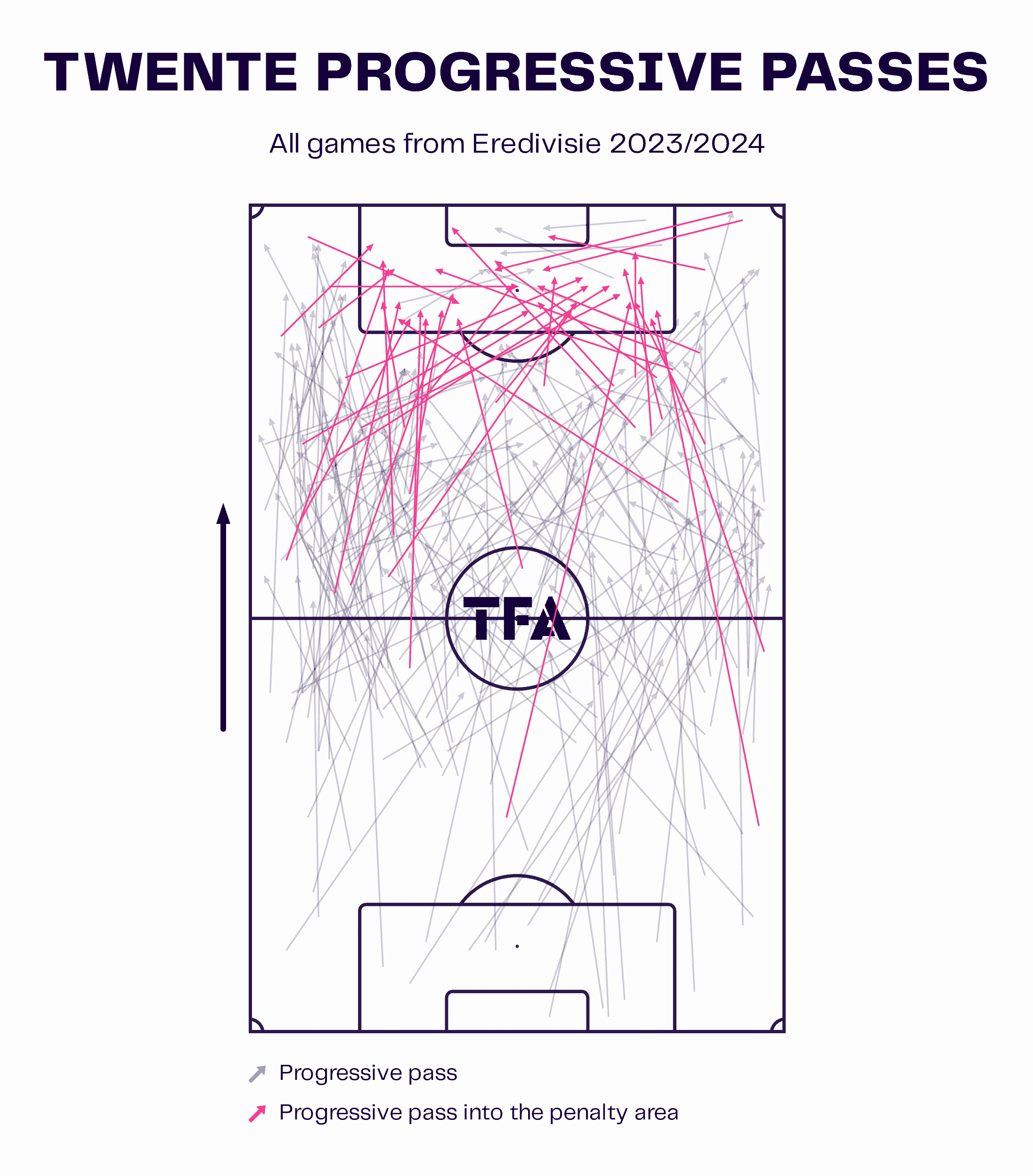
The data viz graphic above shows the progressive passes for Twente through their first four matches in the Eredivisie this campaign.
As the graphic illustrates, most of these passes have originated from the half-spaces.
This is due to the movements of the full-backs for Joseph Oosting’s side, with them looking to invert when Twente are in possession and occupy these spaces, looking to overload the midfield and give them positional superiority over their opposition.
Many of these progressive passes also originate from quick vertical passing sequences; this, along with the rotations and movements off the ball, have been critical to Twente’s start from an attacking aspect this season.
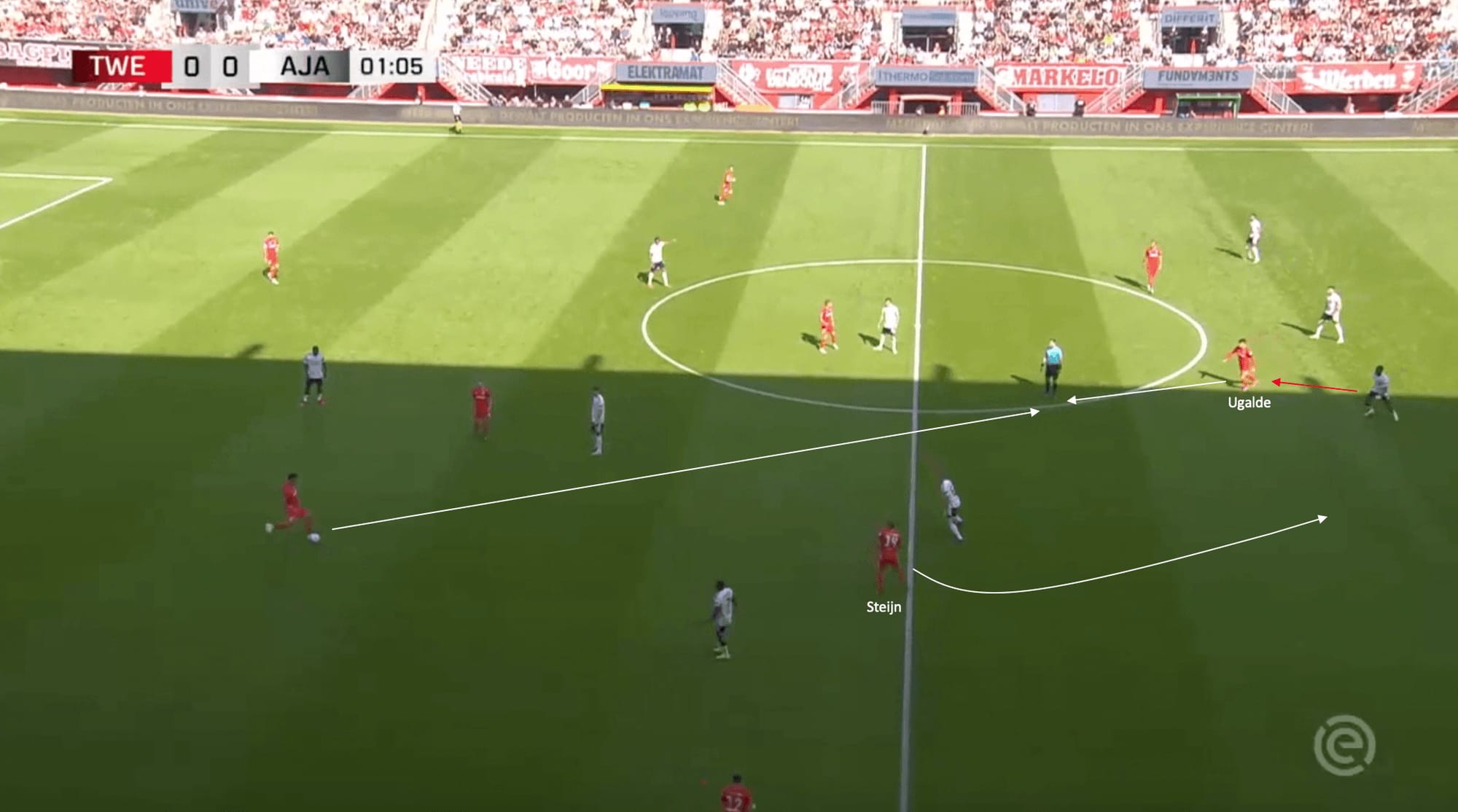
The following two images show a little peek at what Joseph Oosting looks for his Twente side to do when they are in possession.
In this phase of play above against Ajax, Twente took a free kick quickly, with Costa Rican striker Manfred Ugalde the target between the lines.
The 21-year-old forward drops off the Ajax backline, looking to drag the central defender out, which he accomplishes.
This allows Dutch attacker Sem Steijn, occupying the half-space, to make a run behind the defence, moving into the vacant space the centre-back is dragged out of.
At the bottom of the image, we can see the positioning of the Twente full-back, Alfons Sampsted, occupying the touchline, keeping the width and preventing the Ajax lines from narrowing — thus overloading the midfield.
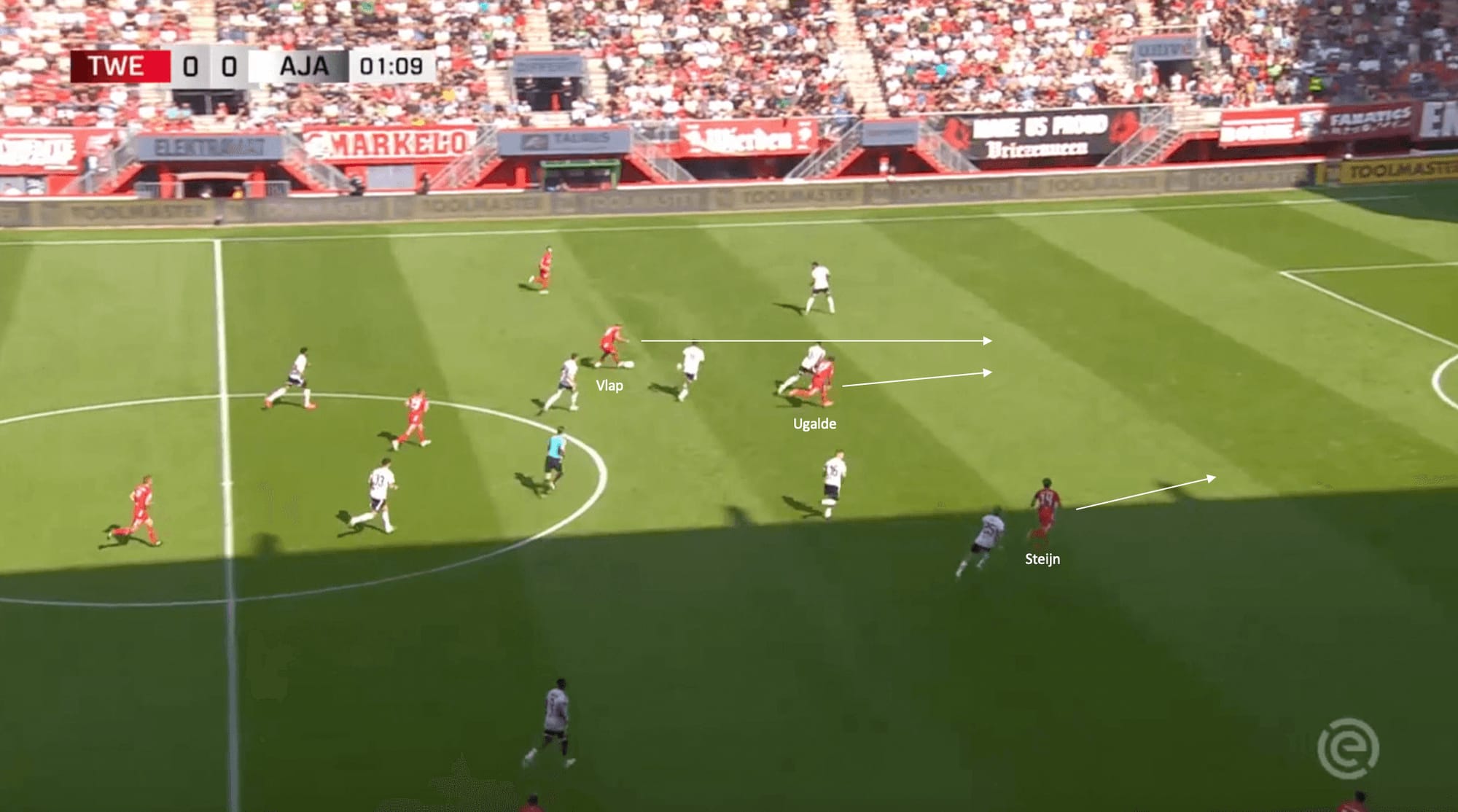
The image above shows the next phase of the attacking move for Twente off the free kick.
After Ugalde received possession and dragged the defender out, he was able to play a pass first time to Michel Vlap, who was sitting in the opposite half-space.
The Dutch midfielder is able to play a through ball into the vast vacant space behind the Ajax defence and the path of Ugalde for the one-two.
Also, Sem Steijn had continued his run, with the 21-year-old Dutchman also finding himself well beyond the Ajax backline.
The ensuing pass from Vlap finds Ugalde, who is able to drive into the penalty box with the ball at his feet.
The Costa Rican forward can get a shot off, but it is saved by the goalkeeper.
Though this attacking phase of play for Twente does not result in a goal, it does give a glimpse into what Joseph Oosting has already begun to implement in his short time in charge.
Steijn and Vlap occupying the half-spaces, along with the movement from Ugalde to drag the defenders out and the clinical two-touch through ball from Vlap, all summarise Joseph Oosting’s Twente in attack.
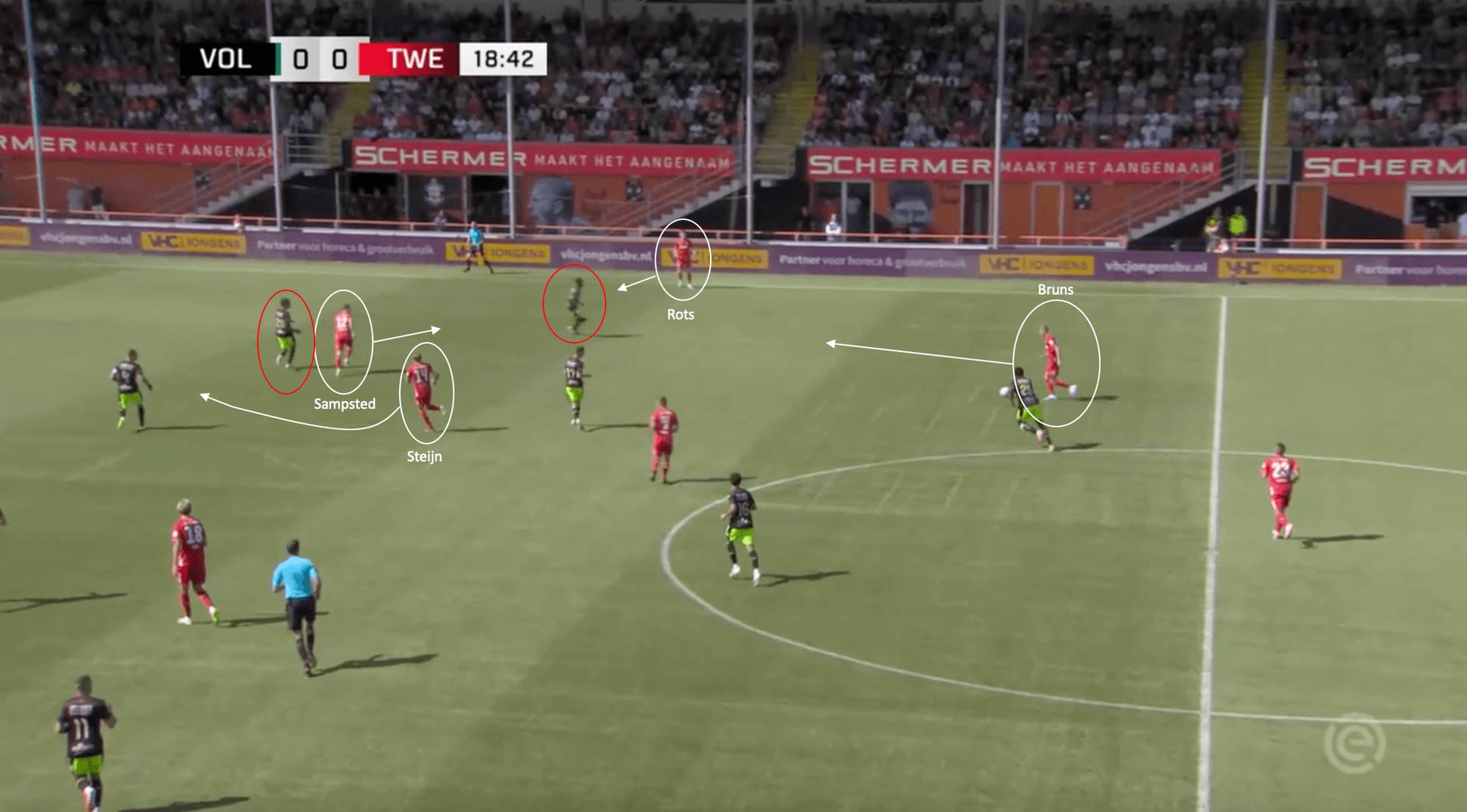
The image above shows an example of the role that the inverted full-back in the half-space plays for Joseph Oosting when Twenter have been in possession this season.
In this phase of play above against Volendam, 25-year-old Icelandic international full-back Alfons Sampsted is occupying an inverted position, playing almost as a right-sided midfielder.
On the touchline is Daan Rots, Twente’s usual starting right-sided midfielder.
What has happened often in matches this season for the Dutch side is that the full-backs will push into advanced positions and become inverted, while the outside midfielders in Oosting’s preferred 4-2-3-1 formation get pushed wide.
This allows Twente to have an extra number forward in the attack to create a positional superiority, at the risk of potentially being exposed in defence.
In this specific phase, Max Bruns, one of the Twente centre-backs, is in possession and drives forward into midfield, with the Dutch side able to create an overload down this channel.
Also, due to Sampsted’s positioning, the closest defender to him gets dragged over, allowing Steijn to make a run into the space.
While this attacking move does not progress into the penalty area for Twente, it is able to highlight what the role of the advanced and inverted full-back accomplishes for Joseph Oosting’s side.
Along with occupying the half-spaces and creating numerical advantages, it also opens passing lanes for the Twente players to play clinical through balls with these movements off the ball, allowing opposition defensive lines to be broken and the ball to progress vertically quickly.
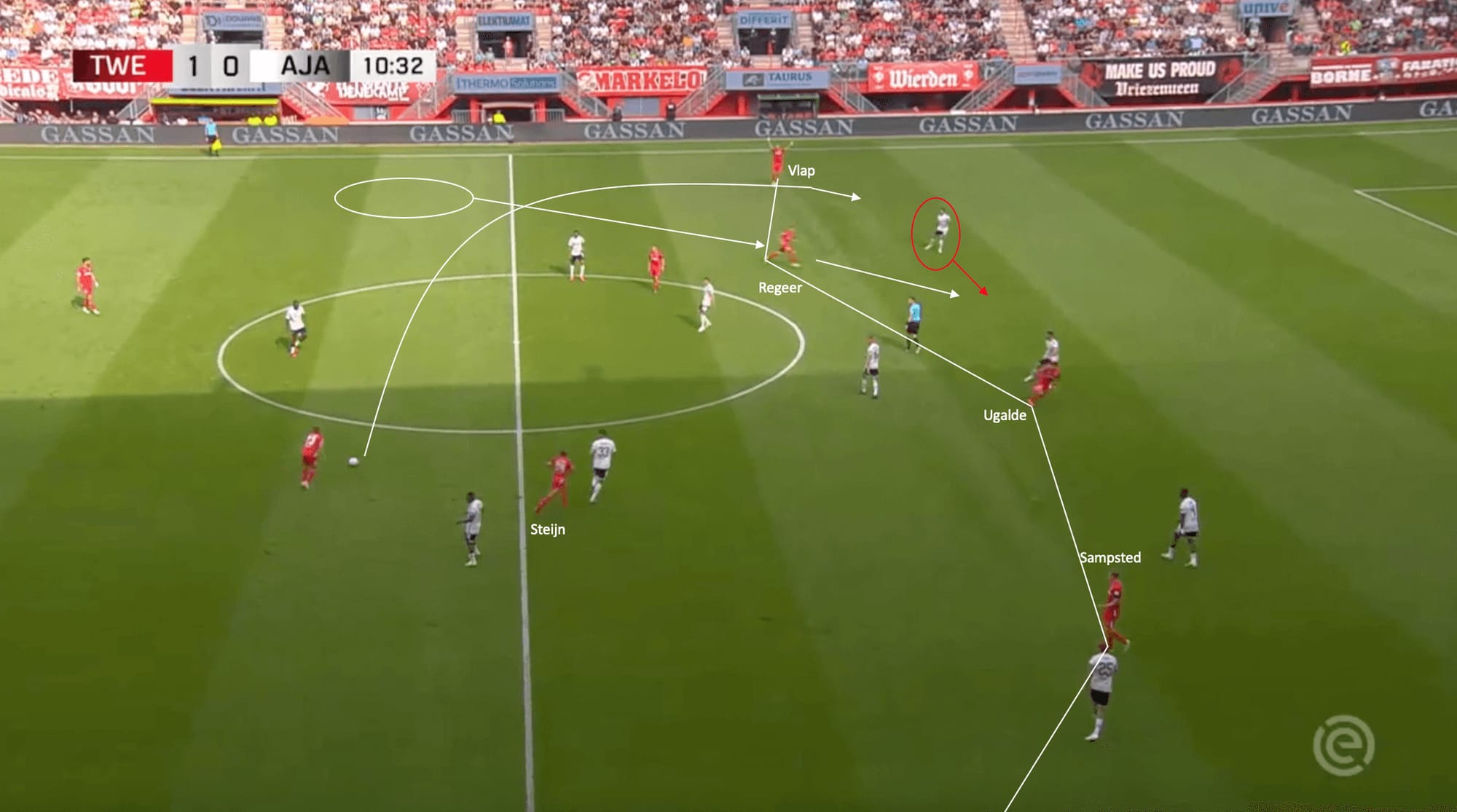
The image above shows an attacking phase for Twente and one that results in a goal against Ajax.
This attacking move is successful due to the movement of the full-backs becoming inverted, with this movement from both Regeer and Sampsted pinning the Ajax defensive line back and forcing the Ajax full-backs into making a decision on who to mark.
In this phase of play, the ball is in possession of the Twente central defender, with Sem Steijn sitting just in front of him.
On the far side, Regeer makes an inverted movement from the deeper and wide position, forcing the Ajax defender to tuck inside, opening up the space for Michel Vlap, who has stayed wide, to receive the long switch of play ball.
After receiving possession, the Dutchman can drive at the Ajax defence, with his ensuing ball across the box causing trouble for the Ajax defenders, with the eventual late run of Sem Steijn allowing him to put the ball in the back of the net.
This attacking style has allowed Joseph Oosting’s side to have great success going forward this season, with the inverted full-backs creating overloads against opposition backlines and allowing Twente to overwhelm opposition defences.
Deeper line of confrontation and good shifting prevents gaps defensively
From a defensive perspective, Twente have had a solid start defensively this season under Joseph Oosting, with the Dutch side having the third-best defence at the beginning of the Eredivisie season, with only three goals conceded through their first four matches.
Most of this defensive success has come due to Oosting’s side having a deeper line of confrontation, with them not looking to press opposition sides often inside and around the penalty box.
Their good use of shifting in defence has also allowed Twente to plug gaps centrally, making it difficult for opposition sides to build through them.
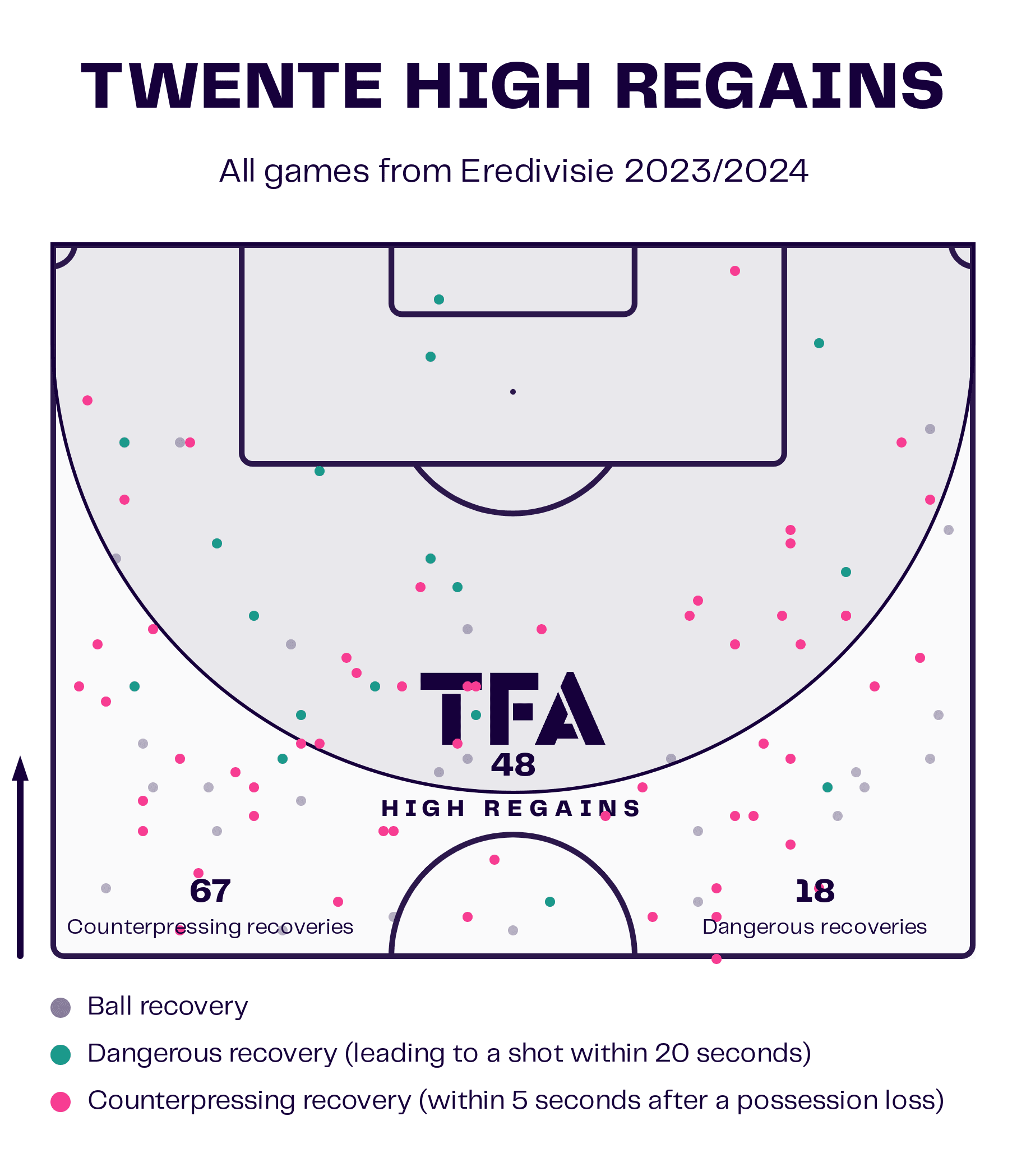
The data viz graphic above highlights the high regains of Twente this season.
As we can gather from the graphic, it backs up the point of Oosting’s side not looking to press opposition sides that high, with most of their counterpressing recoveries and dangerous recoveries occurring in the wide areas and deeper central areas, and more specifically about 15 yards or so outside the penalty box.
They also can shift well when forced back into a defensive shape, plugging gaps centrally and frustrating opposition sides during build-up phases.
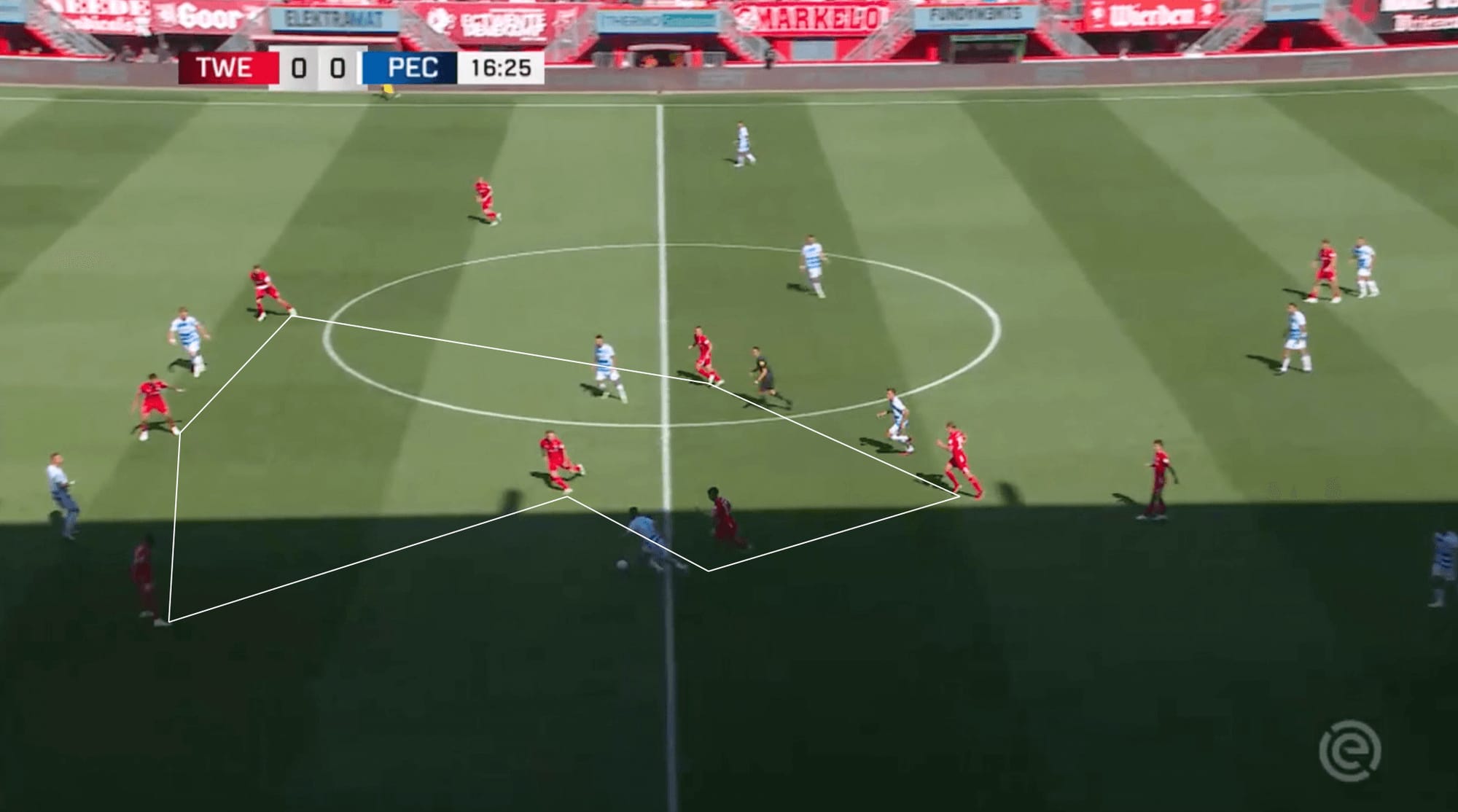
The image above shows an example of Twente’s compact and narrow defensive shape that has allowed them to eliminate opposition attacks this season.
In the phase of play above, PEC Zwolle are in possession and looking to play the ball into the central area.
The first thing to notice is how narrow Twente is, with the weak side full-back tucked inside, allowing space for Zwolle on the switch but preventing the ball from being played centrally and creating overloads in these areas.
Due to the narrow shape of Oosting’s side, the ball played centrally by the Zwolle player on the near side is intercepted, allowing Twente to gather possession and start a counterattacking sequence of play.
While this tight and compact defensive shape opens up gaps in the wide areas for the ball to be played out to, it eliminates the opportunity for opposition sides to play centrally.
It allows Twente to shift well when playing the ball into these wide channels.
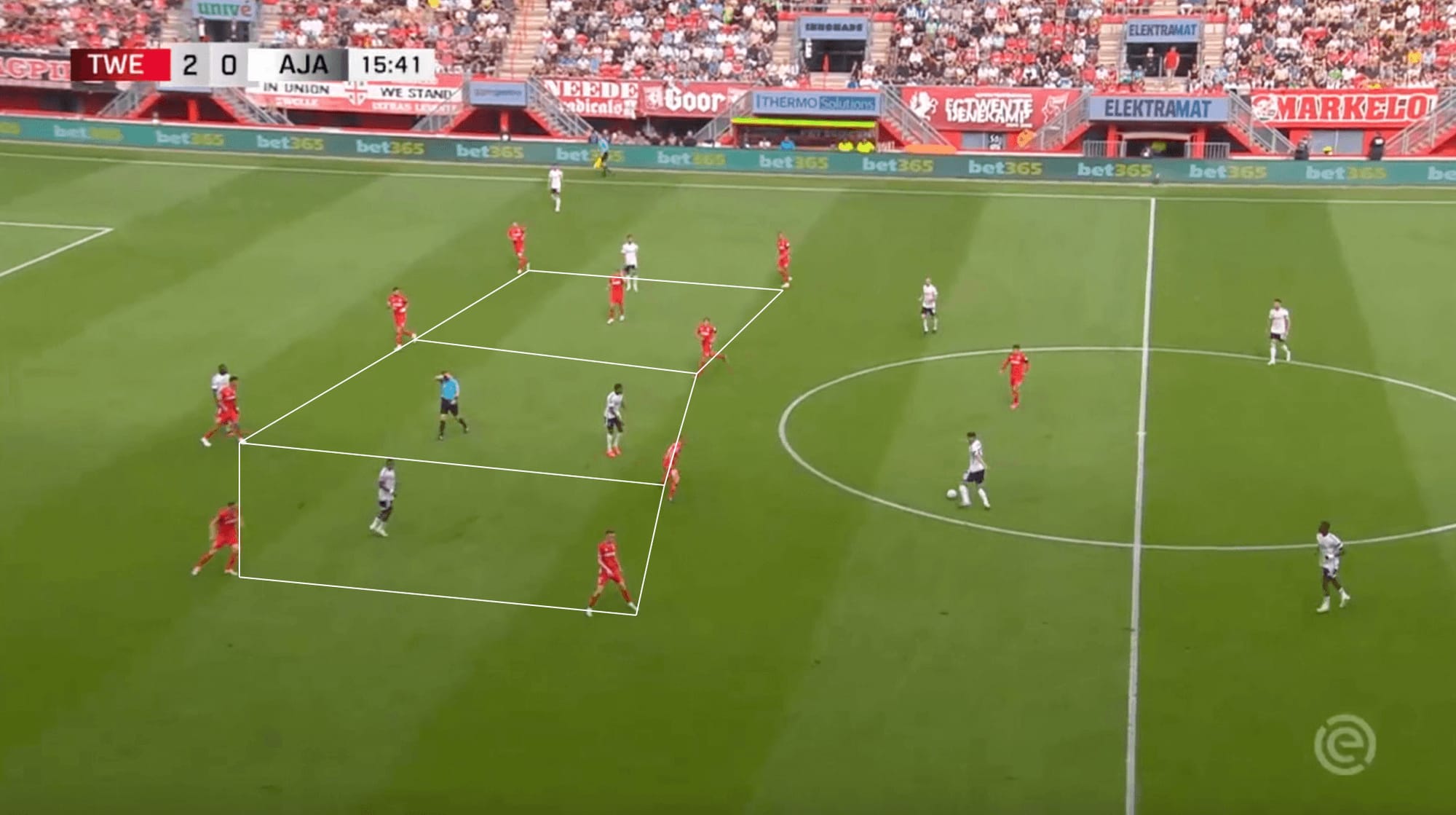
The image above shows another example of the compact and narrow shape that Twente look to defend using.
In this phase of play above, again against Ajax, we can see how Twente look to use box shapes with their midfield and defensive line to eliminate opposition sides playing into the central areas.
As we can see, the three Ajax players in central areas are entirely blocked off by Twente’s narrow shape, with the only true progressive option a potential switch to the winger in some space on the far side.
However, the player in possession instead tries to play the ball vertically and centrally into Ajax captain and former Tottenham Hotspur player Steven Bergwijn.
The pass to the Dutch winger is intercepted by the Twente midfield, allowing them to relieve some pressure and continue to get organised into a defensive shape.
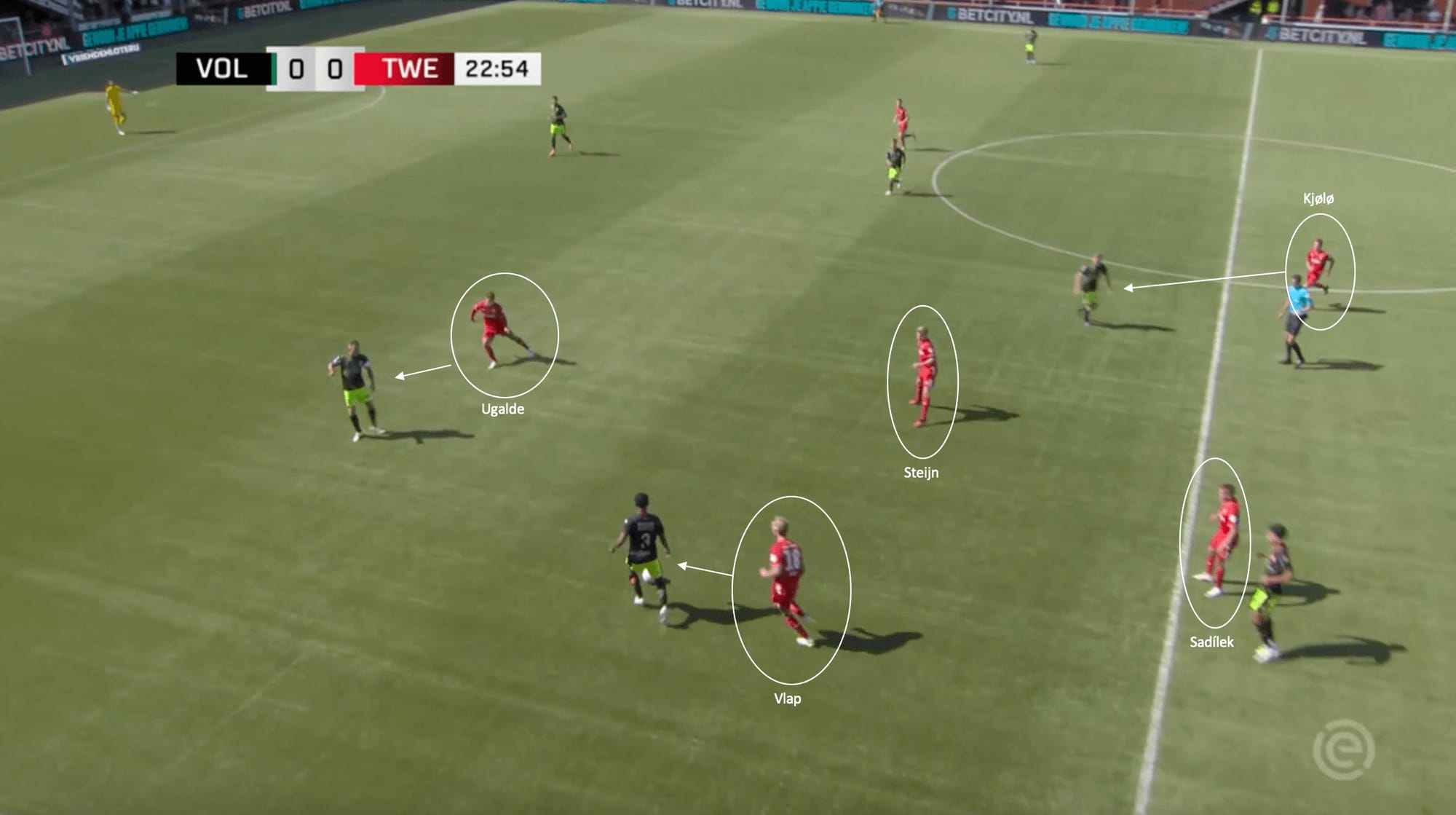
The image above shows the style of pressing that Joseph Oosting has implemented during the first few matches of his tenure at Twente.
In this phase of play, the ball originated with a goal kick from Volendam, with the ball finding its way to its current position in possession of the full-back.
As we can see, the furthest advanced Twente players all look to shift over and lock the ball to one side, preventing Volendam from looking for a switch of play to escape the pressure.
Michel Vlap is putting pressure on the full-back from behind, forcing him to play the ball back to the centre-back.
This is the only realistic passing option for the defender.
Sem Steijn is doing a good job blocking the passing lane to the centrally positioned player, while Mathias Kjølø is shifting over also to put pressure on this player.
Manfred Ugalde is also doing a good job eliminating the channel for the ball to be played to on the other side.
As the central defender receives possession, the instant pressure from the Costa Rican forward forces him to play a long ball forward, with the Twente defence able to collect and begin an attack of their own.
As this section has shown, the defensive tactics that Oosting has implemented have worked well so far, with this another reason for their unbeaten start to the Eredivisie season.
Conclusion
As this tactical analysis and scout report has shown, Twente may be a surprise team to watch this season in the Eredivisie.
While they have recently been there and thereabouts regarding challenging the top three teams in the Netherlands, now may finally be the season they achieve that goal, with Joseph Oosting’s appointment in the summer proving to be an excellent choice by the hierarchy at the Dutch club.





Comments